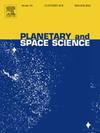Relaxation probe measurement in the Earth's and Titan's atmospheres: Effect of shadow
IF 1.7
4区 物理与天体物理
Q3 ASTRONOMY & ASTROPHYSICS
引用次数: 0
Abstract
In this work, we investigate the shadowing effect of the boom and the gondola on electrical conductivity measurement in the stratosphere using a Relaxation Probe (RP). By taking the examples of the terrestrial flight for the Huygens experiment and the Huygens mission to Titan, our numerical simulations demonstrate that this effect should be taken into account, particularly for the resistance of the electrode-ionized medium during both the apogee and descent of a balloon. The fact that a signal seems a perfect exponential does not allow one to accept the hypothesis of a measurement at face value, and a correction factor should be applied. Our numerical simulations show that the resistance and the capacitance are almost constant, independent of the potential of the electrode. This makes the correction of the data an easy task. This analysis was carried out using finite element methods to model a complex electrode-boom-gondola geometry. In our model, the potential around the electrode-boom-gondola system is described by a Laplace equation, and this corresponds well to the stratospheric environment. We shall emphasize the crucial importance of estimating the floating potential of the gondola during a flight from the relaxation data of the potential. From our numerical simulations, it appears that the resistance may be too high by a factor 1.72, depending of course on the length of the boom. Also, the measurement of the positive ions by the RP for the Huygens mission around Titan does not seem too reliable. In this case, we found a heavy shadowing effect of the gondola. We hope that this work will aid in the optimal design of future planetary missions, taking into account the length of boom and, given the constraints of a mission, whether the boom should be an insulator, or a conducting body.
地球和土卫六大气中的松弛探测器测量:阴影的影响
在这项工作中,我们研究了使用松弛探针(RP)测量平流层中吊杆和吊舱的阴影效应。以惠更斯号地面飞行实验和惠更斯号土卫六任务为例,我们的数值模拟表明,这种影响应该被考虑在内,特别是在气球远地点和下降时电极电离介质的阻力。信号似乎是一个完美的指数,这一事实不允许人们接受表面上的测量假设,并且应该应用校正因子。我们的数值模拟表明,电阻和电容几乎是恒定的,与电极的电位无关。这使得更正数据成为一项容易的任务。采用有限元方法对复杂的电极-吊杆-吊篮几何结构进行了分析。在我们的模型中,电极-吊杆-吊篮系统周围的电势用拉普拉斯方程描述,这与平流层环境很好地对应。我们将强调根据势能的弛豫数据估计吊篮在飞行过程中的浮动势能的关键重要性。从我们的数值模拟来看,阻力可能过高了1.72倍,当然这取决于吊杆的长度。此外,惠更斯号环绕土卫六的任务中,RP对正离子的测量似乎也不太可靠。在这种情况下,我们发现了贡多拉的严重阴影效应。我们希望这项工作将有助于未来行星任务的最佳设计,考虑到臂架的长度,并考虑到任务的限制,臂架应该是绝缘体还是导电体。
本文章由计算机程序翻译,如有差异,请以英文原文为准。
求助全文
约1分钟内获得全文
求助全文
来源期刊

Planetary and Space Science
地学天文-天文与天体物理
CiteScore
5.40
自引率
4.20%
发文量
126
审稿时长
15 weeks
期刊介绍:
Planetary and Space Science publishes original articles as well as short communications (letters). Ground-based and space-borne instrumentation and laboratory simulation of solar system processes are included. The following fields of planetary and solar system research are covered:
• Celestial mechanics, including dynamical evolution of the solar system, gravitational captures and resonances, relativistic effects, tracking and dynamics
• Cosmochemistry and origin, including all aspects of the formation and initial physical and chemical evolution of the solar system
• Terrestrial planets and satellites, including the physics of the interiors, geology and morphology of the surfaces, tectonics, mineralogy and dating
• Outer planets and satellites, including formation and evolution, remote sensing at all wavelengths and in situ measurements
• Planetary atmospheres, including formation and evolution, circulation and meteorology, boundary layers, remote sensing and laboratory simulation
• Planetary magnetospheres and ionospheres, including origin of magnetic fields, magnetospheric plasma and radiation belts, and their interaction with the sun, the solar wind and satellites
• Small bodies, dust and rings, including asteroids, comets and zodiacal light and their interaction with the solar radiation and the solar wind
• Exobiology, including origin of life, detection of planetary ecosystems and pre-biological phenomena in the solar system and laboratory simulations
• Extrasolar systems, including the detection and/or the detectability of exoplanets and planetary systems, their formation and evolution, the physical and chemical properties of the exoplanets
• History of planetary and space research
 求助内容:
求助内容: 应助结果提醒方式:
应助结果提醒方式:


